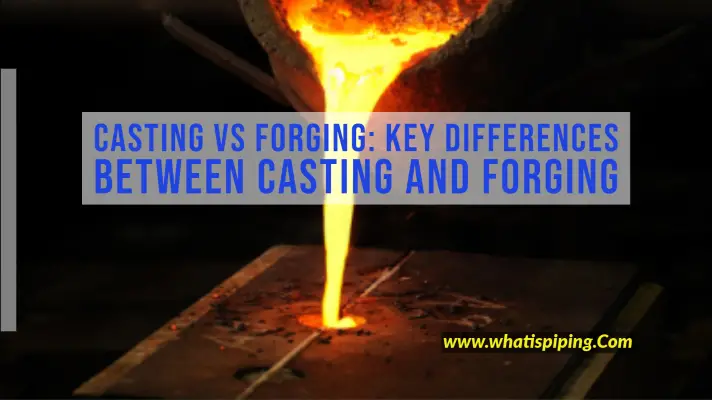Both Cast iron and Cast steel are ferrous products containing iron and carbon as the major components. Cast iron is a ferrous material containing more than 2% carbon. On the other hand, Cast steel contains less than 2% carbon. So composition-wise the main difference is the amount of carbon present in cast iron and steel. Both cast iron and steel provide very good casting properties and are therefore used for a wide range of applications. Both cast iron and cast steel have very good mechanical properties. In this article we will explore the major differences between cast iron and cast steel; i.e Cast iron vs Cast steel.
Cast Iron vs Cast Steel
The main differences between cast iron and cast steel or Cast iron vs Cast Steel are provided below in a tabular format.
| Cast Iron | Cast Steel |
| Cast Iron is very easy to cast due to its very good flowability and low shrinkage. | Cast Steel has less flowability and more shrinkage as compared to Cast Iron. |
| Cast iron is better in terms of corrosion resistance and resistance to mechanical wear. | Cast steel is better in terms of impact loads. |
| Cast iron is cheaper. | Cast Steel is costlier as compared to cast iron. |
| Cast iron has very good vibration-damping properties. | In terms of vibration damping, cast steel is inferior to cast iron. |
| Cast iron is more Brittle in Nature. | Cast steel is Ductile in nature. |
| The Machinability of cast iron is lower. | Cast steel provides good machinability. |
| The Weldability of cast iron is lower as compared to cast steel | Cast steel exhibits Good Weldability |
| Cast Iron has a relatively Low melting point | Cast Steel possesses higher melting points. |
| The main element in Cast iron in Iron and Carbon. Other elements can be present in a negligible amount. | Other alloying elements are present in cast steel in considerable amounts. |
Cast Iron vs Cast Steel: Which one to Select?
Even though cast iron and cast steel have their own advantages and disadvantages; the selection between cast iron vs cast steel completely depends on the end use and application of the product.
Choosing Cast Iron:
- If mechanical strength is of less importance then cast iron is a great choice.
- Select cast iron if heat retention is required as cast iron has higher thermal capacities.
- If the more compressive strength is required, go for cast iron.
- If you need an economical item then choose cast iron as grey iron is cheaper to produce.
- The use of Cast iron is normally limited to low-temperature and pressure applications.
Choosing Cast Steel:
- If ductile behavior along with good strength is the requirement then choose Cast Steel.
- If the end product is to be used in impact loading conditions use Cast Steel as it has higher toughness properties.
- If you need very good thermal and electrical conductivity, select cast steel.
- Choose Cast Steel for flexibility in design.
- Use Cast Steel for high-temperature and pressure applications.
Cast Iron vs Cast Steel: How to Identify
There are various methods for the identification of Cast iron vs Cast Steel. Some methods are listed below:
Chemical Analysis: This is the best method to determine if a specimen is Cast iron or Cast Steel. The analysis will specifically determine the elements and percentage of carbon present from which steel and iron can easily be distinguished.
Spark Test: One of the easier methods to check cast iron vs cast steel is by spark test. The specimen can be grinded using an abrasive wheel and looking at the spark pattern and spark color, an experienced person can inform if the material is Cast iron or cast steel. Steel will most often give off bright yellow sparks, whereas iron produces more red or orange sparks.
In cast iron, the spark color tends to be the brightest at the end of the spark whereas for cast steel the spark originates at the grinding wheel and extends outwards.
Drilling Test: Drilling cast iron vs cast steel looks completely different. In cast iron, the generated chips are of very short length and resemble graphite flakes. On the other hand, the chips of cast steel form wire-like chips.
Grain Structure: Cast iron vs cast steel can also be identified by looking at the grain structures of the broken parts. The grain structures for cast iron and cast steel are completely different and one experienced engineer can easily differentiate between the two.









Good work and thanks for the information
Congrats Anup,
Good article.
Good Article.
Simple & best explanation.
Thank You Mr. Anup,
Very useful information shared by you for industrial piping engineers or maintenance person.
I request you to share an idea or demo how to manage piping spares for different standards, as we know numbers od Sizes, types , material and standards are there for a single item, for example an elbow fitting- Socket Weld,Butt Weld, Long Radius-Short Radius, 90-45-60, Material Grade-St35,St37,St52,SS304etc. If I need to keep a record for elbow in a single excel sheet for ease of identification when required how can it be? If you have and idea on it please share with a demo format in excel.
Much appreciated
Hi, great post, I need to weld cast iron to mild steel ( repairing some railings) do you know if this is possible? Which rods would be best? Thanks
https://www.materialwelding.com/what-is-the-best-welding-rod-to-use-for-cast-iron-find-it/
its covered here.
Thank you for informative article with practical information. I found identifying characteristic of the materials most helpful.
I have a craftsman table saw, cast iron top. I would like to change it to a router top by using a router insert plate. In your opinion what would be the best way to cut the insert plate dimensions. Thank you for your time.
Please , i need your suggestion , we have diaphragme pump in chemical service with 40 % NAOH at 8 bar , which material is good between cast iron and cast steel